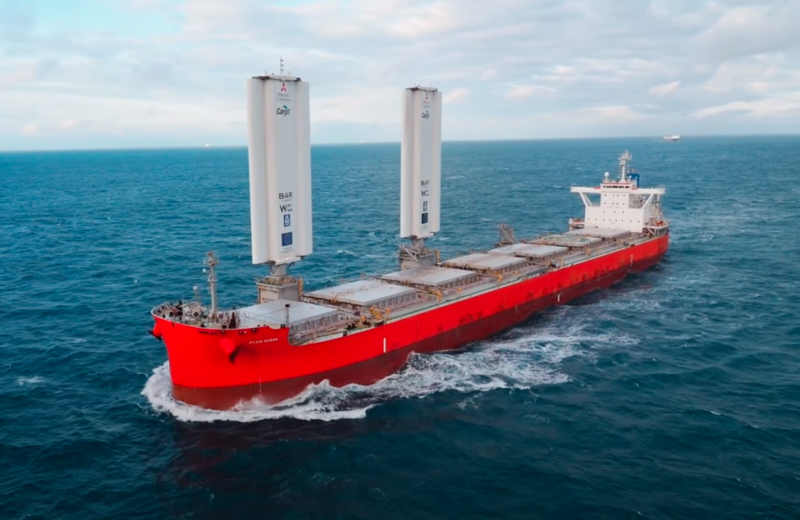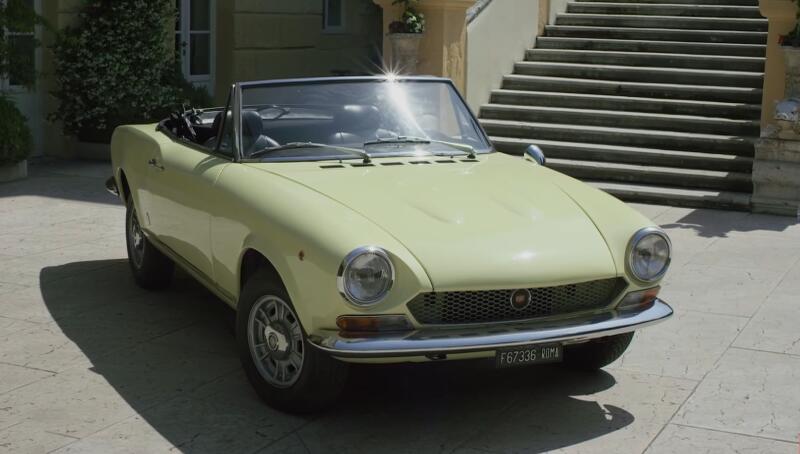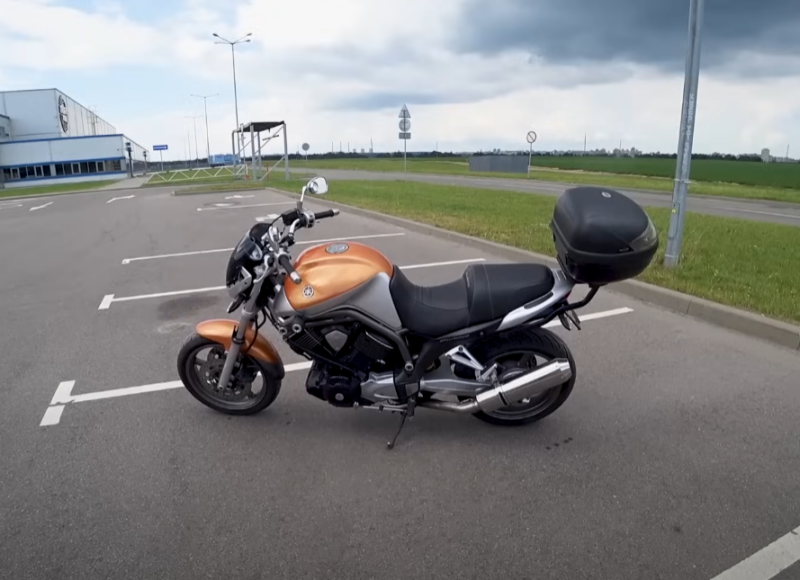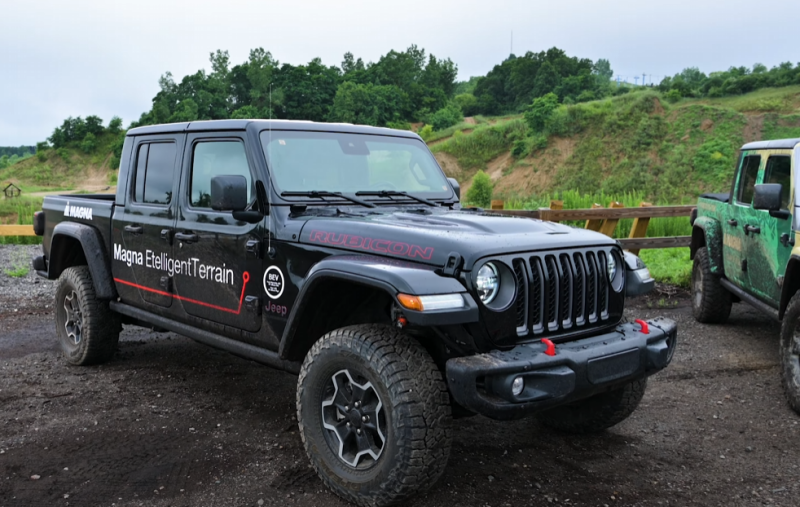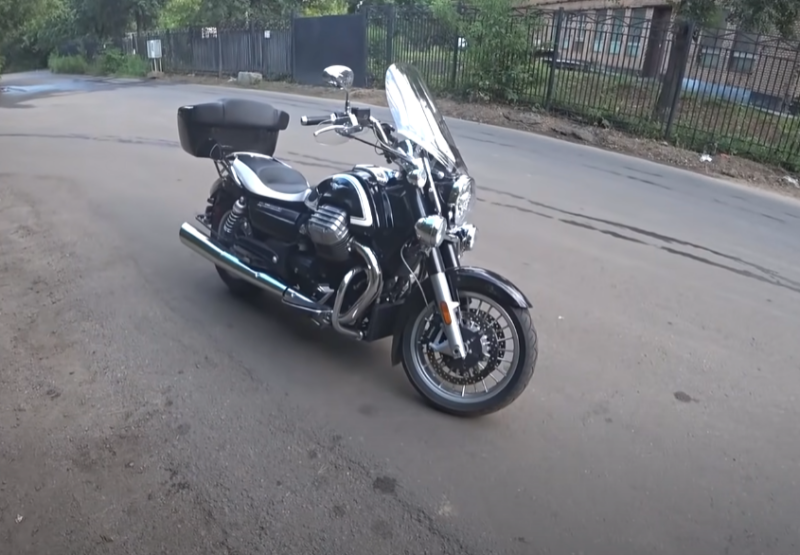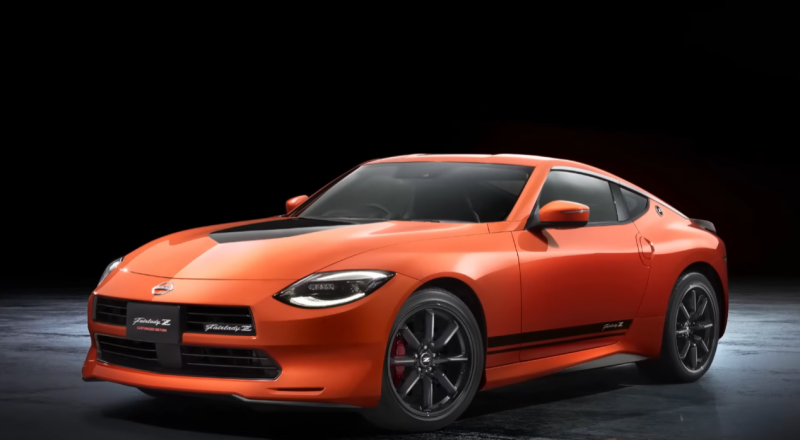They left scraps of canvas and silk for walks and sports on yachts and other fragile shells. And large ships began to cut through the waves with the wild force of thousands of “horses.” And here comes the sail again.
And what happened?
The atmosphere has been polluted by emissions from internal combustion engines to a critical level. It’s not just megacities that are suffocating. Even in the ocean, where free winds blow, you can’t take a breath of fresh air.
 WindWings sails on the grain carrier "Ocean Pixis". Photo: YouTube.com
WindWings sails on the grain carrier "Ocean Pixis". Photo: YouTube.comLet’s imagine: a large-capacity ship burns 40 tons of diesel fuel per day. The transition from St. Petersburg to a European port requires about 800 tons of fuel. To get to other continents, take 2,5 thousand tons of fuel. Now let’s imagine the scale of modern cargo and passenger transportation.
Astronomical numbers are difficult to comprehend in the brain. One can understand environmentalists with their claims. The issue of decarbonization—reducing carbon dioxide emissions—has been taken seriously by advocates for the purity of nature.
Shipping companies, facing the real prospect of sanctions, began to think. We started looking for a way out of the situation. On the one hand, there is exorbitant fuel consumption, on the other – environmental pollution and fines. The solution to the problem, meanwhile, lay on the surface - the wind! What if we use its mighty power? Yes, like in the old days, by means of a sail.
Wind-driven traction: technologies
The problems of wind energy have begun to be solved in academic circles and the industry as a whole. It is clear that it is necessary to capture the kinetic energy of air masses and convert it into thrust for the ship.
 The sail on the Ocean Pixis cargo ship folds when necessary. Photo: YouTube.com
The sail on the Ocean Pixis cargo ship folds when necessary. Photo: YouTube.comShould we create new engines and watercraft, or modernize old ships equipped with internal combustion engines? The second option is more economical. Moreover, they promise quotas for reducing emissions.
But how to arrange everything correctly? First of all, we had to think about dry cargo ships: they consume diesel more than others and pollute the air. Scientists' heads began to dance at the structural features of bulk carriers: they have a huge deck, and, based on the specifics, it is smooth and clean.
The sail, or whatever the wind catching device is called, should not interfere with the operation of the harbor cranes. First condition. Second: it must be easy to maintain. Otherwise, a large number of ship crew members will have to be involved. What is the benefit then?.. We came up with three options for wind generators.
Kite sail
This is a giant kite launched from the bow of a craft. The effect is very familiar to kiteboarding enthusiasts. Wind energy pulls the rider across water, land, and snow. Why not use the device on ships, the engineers asked. The idea was especially popular in 2012.
 A kite is launched from the container ship MS Beluga Skysails. Photo: YouTube.com
A kite is launched from the container ship MS Beluga Skysails. Photo: YouTube.comYou can launch not one, but many kites, and control them electronically. Better yet, consistently release and retract the kite rig on the reel, causing it to generate energy. In the higher layers of the atmosphere, the wind is stronger and more stable: this is where the instrument needs to be directed.
The first to have the honor of testing the technology was the commercial container ship MS Beluga Skysails. The area of the auxiliary power unit was 160 m2. The kite was gliding over water at an altitude of 100 to 500 m. Fuel savings amounted to 20%.
Flettner rotor
This development is over 100 years old. Created, tested and forgotten. They came to their senses in 2010, when shipping companies faced huge fines for toxic emissions.
 Maersk Pelican tanker with two Flettner rotors. Photo: YouTube.com
Maersk Pelican tanker with two Flettner rotors. Photo: YouTube.comThe essence of the Flettner rotor technology is as follows: a mechanically rotated cylinder is installed vertically on the deck. Upon contact with streamlined air currents, thrust is created, which moves the cargo ship.
The mechanism is controlled by one operator, who only needs to monitor the speed of rotation of the rotor. In 2018, the following ships sailed the seas with rotors: the tanker Maersk Pelican, the cruise ship Viking Grace, and the bulk carrier Afros. Efficiency – 30% fuel savings.
Wingsail
This wind power engine is closest to the concept of “sail”. The development was ordered by the US government in the 80s. The motivating factor was the severe oil crisis.
 A bulk carrier with WindWings sails fascinates some, but seems rude to others. Photo: YouTube.com
A bulk carrier with WindWings sails fascinates some, but seems rude to others. Photo: YouTube.comThe wingsail is designed like this: a cylindrical mast is mounted on the deck. Solid rectangular metal planes are attached to it symmetrically on both sides. Isn't it a sail?
Technology that is called innovative, progressive, isn’t it “well forgotten...”? The system is automated and maintains the orientation of the sails, no matter what angle the wind blows. The structure is controlled by a lifting mechanism.
About the bulk carrier Pyxis Ocean
On the grain carrier "Ocean Pixis" with a deadweight of 80 tons, wingsails (wingsails) are "rinsed". The vessel was built by order of Mitsubishi Corporation in 962. Home port - Singapore.
Bulk carrier parameters:
✅ Length - 229 m
✅ Width - 32 m
✅ Draft - 15,6 m
The ship was chartered by the American global food corporation Cargill. She ordered the modernization of the watercraft - the installation of an additional wind power engine in the form of sails.
The head of the organization, Jan Dieleman, said:
At Cargill, we are responsible for driving decarbonization solutions across our supply chains to meet the needs of our customers and the needs of the planet
The development was undertaken by the British consulting company in the field of marine engineering BAR Technologies. Here they did drawings and calculations. The technology was called WindWings. Translated - “wind wings” or “wings of the wind”.
The structure was built by the Norwegian company Yara Marine Technologies. And the installation was carried out in Shanghai, China at the COSCO shipyard. However, they resorted to a complex and costly scheme in order to save fuel and preserve the purity of nature.
WindWings Challenges
“Wings of the Wind” is a monumental structure 37,5 m high. The width of the sails itself is 5 m, the central column is 10 m. How much the hulk weighs is not mentioned. There are two folding sails mounted on the Ocean Pixis deck. Rigid composite structure with rotating segments.
 The height of the structure on the bulk carrier Pyxis Ocean is 37,5 m. Photo: YouTube.com
The height of the structure on the bulk carrier Pyxis Ocean is 37,5 m. Photo: YouTube.comThis sail will not flutter in the wind and does not look romantic, if not downright rude. But beauty fades into the background when practicality is needed. Metal, glass and composite materials were used to make “wind wings”. As befits a sail, it will be retracted when entering the port and under bridges.
We must pay tribute to the bulk carrier Pyxis Ocean, which decided on a bold experiment. The risk is enormous; it is impossible to foresee all scenarios in the open ocean. For example, storms, strong lists, and other circumstances that accompany sea vessels along the way.
 The scale of the structure on the deck of the Ocean Pixis can be judged by the numbers. Photo: YouTube.com
The scale of the structure on the deck of the Ocean Pixis can be judged by the numbers. Photo: YouTube.comBut, disdaining “expensive and extremely stupid”, “a nightmare for the crew” and other unflattering comments, the bulk carrier left Shanghai for Singapore. Then he proceeded to Brazil. The event took place on August 22, 2023.
After a month of a successful voyage, the wind-powered craft reached its final goal. Then, with bulk cargo on board, it went to Poland. Along the way, the crew made careful measurements - 30% fuel savings. Essential. But the followers are not visible...
